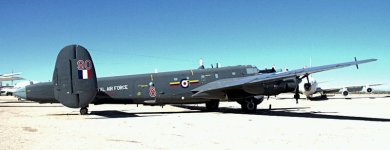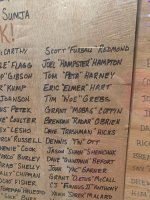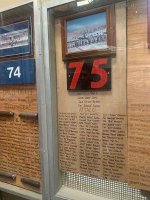Mynarski Memorial Lancaster named in honour of Winnipeg war hero Andrew Mynarski

Nicknamed VeRA for its flight initials, VR-A, it is also known as the Mynarski Memorial Lancaster in honour of Andrew Mynarski, who grew up in Winnipeg's North End and died trying to help rescue a trapped crew member aboard a Lancaster that was on fire and going down.
Unable to free his friend, tail gunner Pat Brophy, and with his parachute and clothing on fire, Mynarski reluctantly gave up and jumped.
He did not survive the fall...
he aircraft, KB726, was attacked from below and behind by an enemy fighter. The plane caught fire, two engines failed, and it began plummeting.
The captain ordered everyone to parachute to safety.
Mynarski strapped on his parachute and was about to abandon the plane when he saw Brophy trapped in his turret. Mynarski ran to help but the hydraulics for the hatch were damaged. After a number of attempts to pull it open, Mynarski repeatedly hit the turret with a fire axe but to no avail.
Brophy yelled for Mynarski to save himself. He crawled through the burning plane, his clothing on fire. When he reached the escape hatch, he stood at attention, saluted his friend and jumped into the night.
Brophy, who survived the crash when the turret broke open and pitched him out, later recounted the story of his friend's heroism, and how Mynarski said, 'Good night, sir,' as he saluted.
Mynarski's descent was rapid due to the burning parachute. He hit the ground hard and also suffered extensive burns. French farmers found him and rushed him to a doctor, but he died soon after at age 27.

Nicknamed VeRA for its flight initials, VR-A, it is also known as the Mynarski Memorial Lancaster in honour of Andrew Mynarski, who grew up in Winnipeg's North End and died trying to help rescue a trapped crew member aboard a Lancaster that was on fire and going down.
Unable to free his friend, tail gunner Pat Brophy, and with his parachute and clothing on fire, Mynarski reluctantly gave up and jumped.
He did not survive the fall...
he aircraft, KB726, was attacked from below and behind by an enemy fighter. The plane caught fire, two engines failed, and it began plummeting.
The captain ordered everyone to parachute to safety.
Mynarski strapped on his parachute and was about to abandon the plane when he saw Brophy trapped in his turret. Mynarski ran to help but the hydraulics for the hatch were damaged. After a number of attempts to pull it open, Mynarski repeatedly hit the turret with a fire axe but to no avail.
Brophy yelled for Mynarski to save himself. He crawled through the burning plane, his clothing on fire. When he reached the escape hatch, he stood at attention, saluted his friend and jumped into the night.
Brophy, who survived the crash when the turret broke open and pitched him out, later recounted the story of his friend's heroism, and how Mynarski said, 'Good night, sir,' as he saluted.
Mynarski's descent was rapid due to the burning parachute. He hit the ground hard and also suffered extensive burns. French farmers found him and rushed him to a doctor, but he died soon after at age 27.






